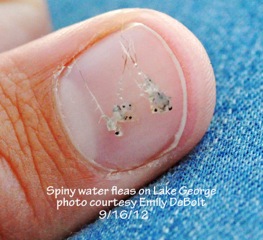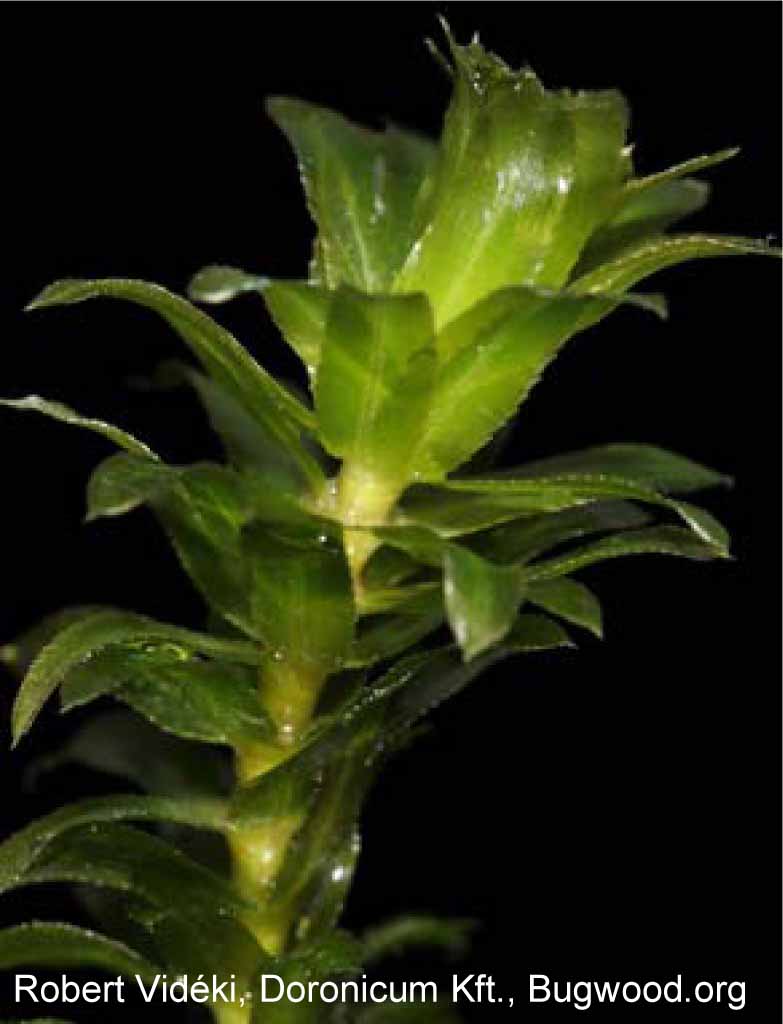Environmental Issues Page
|
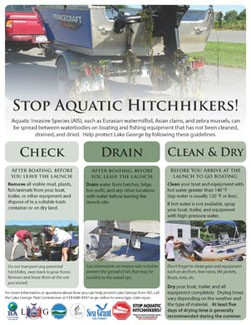 |
 |
Milfoil is an attractive plant with feathery underwater foliage. It was once commonly sold as an aquarium plant. Accidentally introduced to North America from Europe, it spread westward into inland lakes and streams, primarily attributed to being carried by boats and boat trailers, with some spreading caused by water birds. In nutrient-rich lakes, it can form thick underwater stands of tangled stems and vast mats of vegetation at the water's surface. In shallow areas, the plant can interfere with water recreation. The plant's floating canopy can also crowd out important native water plants. Plants grow well in 3-20 feet of water and often have plant stems as long as 20 feet.
A key factor in the plant's success is its ability to reproduce through stem fragmentation and underground runners. A single segment of stem and leaves can take root and form a new colony. Fragments clinging to boats and trailers can spread the plant from lake to lake. The mechanical clearing of weed beds for beaches, docks, and landings creates thousands of new stem fragments that can drift with the wind and current. Removing native vegetation creates perfect habitat for invading Eurasian water milfoil
The introduction of milfoil can drastically alter a water body's ecology. Milfoil forms very dense mats of vegetation on the surface of the water. These mats interfere with recreational activities such as swimming, fishing, water skiing, and boating. The sheer mass of plants can cause flooding and the stagnant mats can create good habitat for mosquitoes. Milfoil mats can rob oxygen from the water by preventing the wind from mixing and oxygenating surface waters. The dense mats of vegetation can also increase the sedimentation rate by trapping sediments. Milfoil also starts spring growth sooner than native aquatic plants and can shade out these beneficial plants. When milfoil invades new territory, typically the species diversity of native aquatic plants declines. While some species of waterfowl will eat milfoil, it is not considered to be a good food source.
Milfoil reproduces extremely rapidly and can infest an entire lake within two years of introduction to the system. Although milfoil produces many seeds, we do not believe that these seeds are important for milfoil reproduction in Washington waters. However, milfoil is able to reproduce very successfully and rapidly through the formation of plant fragments. In the late summer and fall the plants become brittle and naturally break apart. These fragments will float to other areas, sink, and start new plants. Milfoil will also grow from fragments created by boaters or other disturbances during any time of year. A new plant can start from a tiny piece of a milfoil plant. This is why milfoil can so easily be transported from lake to lake on boat trailers or fishing gear. Once established in its new home, water currents may carry milfoil fragments and start new colonies within the same water body.
Talk by many community member and lake representatives has indicated that the presence of milfoil affects property values. A recent study concerning real effects on Vermont property values can be found here. Economic Impact Survey of Eurasian Watermilfoil Removal from Houghton Lake. The real effects on Property Values.
| The Real Effects on Property Values | ||
10-20-2014 APIPP- The Actual and Potential Economic Impact of Invasive Species on the Adirondack Park
|
Ecological Economics- The effect of an aquatic invasive species (Eurasian watermilfoil) on lakefront property values. Zhang and Boyle 8-2010. | Economic Impact Survery- of Eurasian Watermilfoil Removal from Houghton Lake |
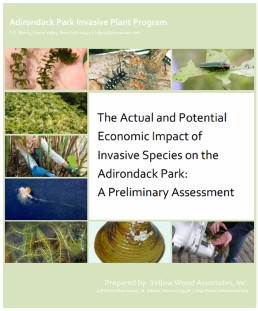 |
 |
 |
Learn More About Milfoil:
A very good page from the Vermont DEC
General Information about Eurasian Water milfoil from the State of Washington
General Information about Milfoil from Lake Luzerne
A technical explanation of milfoil from Dr. Johnson @ Cornell University facts and herbivore activity
Once milfoil becomes well-established within a water body, it is difficult or impossible to remove. There are many techniques that have been employed to control it these include hand pulling, benthic bottom barriers, mechanical harvesting, diver operated suction dredging, "rotovation" biological controls, and select herbicides. Each method has its' advantages and disadvantages for a full discussion of lake management see the link to our lake management page below.
- Lake Management Planning Guides Page- General guides to forming a lake management plan as well as management alternatives on other lakes.
- Lake Management Plans (Eagle Lake) Page- a brief synopsis of the more viable milfoil control methodologies (including benthic barriers, herbicide, hand/mechanical harvesting, etc.) as outlined in the ENSR Supplemental Environmental Impact Statement for Eagle Lake.
ADEQUATE WARNING AND NOTIFICATION?
Adequate public notification and signs about milfoil and other potential aquatic invasive species, is crucial to stopping the spread. Here are examples of effective and ineffective warnings concerning milfoil. Left to right: New Hampshire, New York, and Vermont.
| New Hampshire | New York State | Vermont |
 |
 |
 |
Michael R. Martin, Certified Lake Manager, President of Cedar Eden Environmental, observed that the VT and NH signs were quite clear in asking visitors to help stop the spreading. The NY sign, however, besides being visually uncompelling, also seems to indicate that "...Eurasian milfoil can be dispersed by fragments and tiny seeds that can remain undetected by the most concerned lake user." This seems to be saying that the lake user shouldn't bother checking for the "invisible" milfoil. Eurasian milfoil is almost exclusively spread by fragments, and the fragment has to include a leaf node (stem with leaf attached), meaning it most likely will be 1/2 inch to 1 inch in size AT A MINIMUM.
NYS in 2008 posted new signs at some Adirondack lakes that indicate "You are entering an infested lake" but fails to mention what the infestation is or what one should do either before entering the lake or when leaving and taking boats and equipment elsewhere.
Acentria ephemerella is a moth in the family Pyralidae. It is native to Europe and Asia but was inadvertently introduced to North America in the 1920's. Adults can fly, however most females are flightless and stay on the water surface where they breed with flying males. The larvae (caterpillars) feed on an array of aquatic macrophytes. However they do have a high preference for and consumption rate of Eurasian water milfoil (Buckingham and Ross 1981).
In 2000, several samples of Eagle Lake milfoil were sent to Dr. Bob Johnson, Cornell University, for analysis for the presence of herbivores. Upon examination, Dr. Johnson reported that the samples contained “a significant population of both Acentria moths and weevils”. In a follow-up sampling by Dr. Johnson in early July 2001 on Eagle Lake, he reported finding only a very limited evidence of either moths or weevils.
Triploid Grass Carp- Triploid grass carp are plant-eating fish from the Amur River Basin and lowland rivers in China and Russia. Grass carp are generally not recommended for milfoil control because milfoil is not a highly preferred food. As a result, the concern is that they can enhance milfoil growth by removing competition from native plants and opening up more area for milfoil to colonize. In Washington state, grass carp can be used for milfoil eradication/control only in water bodies where the eradication of ALL submersed aquatic plants can be tolerated.
Assessing the Potential for Bio-Control of Eurasian Watermilfoil in New York State Lakes (FL-LOWPA) 02-2009
Brant Lake Milfoil Control: Internet Research on the Milfoil Weevil, David King (Personal Opinion)
Research on Herbivore's effect on milfoil: 2000 Johnson et. al "Experimental evidence for changes in submersed macrophyte species composition caused by the herbivore Acentria ephemeralla (Lepidoptera)"
Bob Johnson Herbivore Study: 2000 Johnson et. al "Eurasian Watermilfoil Biomass Associated with Insect Herbivores in New York"
Acentria Moth pictorial lifecycle Cornell Cooperative Extension
Aquatic Weevil that eats milfoil: information Cornell Cooperative Extension
Eurasian Watermilfoil- facts and herbivore activity in NY by NYS Seagrant Bob Johnson and Bern Blossey article.
Lake Management and The Milfoil Solution Lake Bonaparte- 182,000 milfoilweevils were stocked 2002-2008 for an average of 26,000 weevils per year, EnviroScience Inc.
|
|
Zebra mussels are small, brown-and-white-striped clam-like animals that pose a serious threat to our fisheries and other water users. They have been found as far west as Thunder Bay and could spread rapidly into our waters if steps are not taken now. Native to the Caspian and Black seas of Eastern Europe, the mussels were first spotted in Lake St. Clair in 1988, apparently brought from Europe in the ballast water of a freighter. They have since spread to all of the Great Lakes. The fingernail-sized mussels attach themselves to the intake pipes of municipal water supply systems and power plants, sharply reducing flows. Zebra mussels cling to rocks, reefs, fishing nets, piers, buoys, and even other creatures such as clams and crayfish. Capable of forming colonies of up to 700,000 mussels per square meter, over 15 centimeters deep, they quickly cover fish spawning beds. They compete with fish by consuming large quantities of plankton, a very important link in the aquatic food chain. In the United States, mussels forced a Michigan hospital to dismiss patients and cancel elective surgery, hiked Detroit Edison's annual maintenance bill by $500,000 a year, and threatened boaters on Lake Erie by sinking navigation markers.
Scientists find bacteria to combat Zebra Mussels (Chicago Tribune)
| USGS Zebra Mussel Distribution |
 |
Asian Clams are a relative of Zebra Mussels.
| Asian Clams | ||
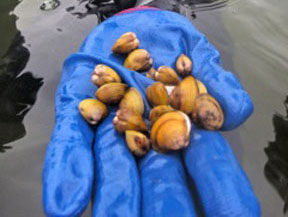 |
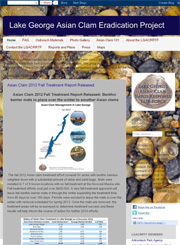 |
 |
|
Asian Clam- A Simple Overview
|
||
Acid rain is rain that is more acidic than normal. Acid rain is a complicated problem. Caused by air pollution, acid rain's spread and damage involves weather, chemistry, soil, and the life cycles of plants and animals on the land and from acid rain in the water.
In the Fall of 2004 a concerned Officer of the ELPOI became involved with the NYS Governors Task Force for Invasive's. This involvement lead to a heightened awareness for invasive's in general as they threaten NY, specifically the Adirondacks and Eagle Lake. In the time that the Task Force took to conduct its research on invasive's and write their final report; six new invasive organisms were found in NYS. Listed below are links and documents that describe but a few of the over 100 plus invasive's that threaten all parts of New York State. These invasive's are on a march from an area near you to your favorite “natural spot of beauty”. Practicing prudent environmental education and cautions as we move ourselves and our possessions (boats/ trailer, fishing gear, cars, building materials, gardening supplies, fire wood etc.) around can help prevent/ slow the spread of these invaders. It will be to all of our advantages to be part of an early detection and “rapid response” (removal) plan for these invaders as opposed to the often very costly, often times impossible and environmentally damaging process of eradicating a large infestation.
| New York State | Other States | ||
|
|||
This section focuses primarily on the terrestrial invasive's that are either threatening the lake community and have been spotted nearby, or that will be threatening us directly in the next few years; as well as those invasive's that are sadly already in the Eagle Lake area.
- Plant Identification Page- Provides resources to help with aquatic/terestrial and native/invasive plant identification.
- Report Invasive Beatles in NYS- You can help us stop the spread of the beetles and the devestation to our forests, parks, and neighborhoods by searching your community for signs of the beetles.
- Emerald Ash Borer Information Page- Here you will find information pertaining to the Emerald Ash Borer( Agrilus planipennis) and it's spread across the New York and the United States. It is an invasive winged insect that as its' name implies attacks ash trees in many instances killing them. This invasive can be managed through proper arboricultural treatments given sufficient lead time before the Emerald Ash Borer attacks your trees!
| Purple Loosestrife | Woodland Terrestrial Invaders | ||
| Purple Loosestrife Identification | Firewood: |
||
| Purple Loosestrife Identification and Control | Affecting Hemlock Trees | Affecting Maple Trees | |
| Purple Loosestrife's threat to Cattails | Hemlock Tree General Information | Elongated Hemlock Scale | Maple Tree Disease |
| Giant Hogweed | Hemlock Wooly Adelgid | Sirex Wood Wasp (3mb) | Affecting Oak Trees |
| Giant Hogweed Fact Sheet | Bugs Fight Bugs- Hope to protect hemlocks from the Hemlock Wooly Adelgid USDA forest service 12-17-2010. |
Fall/Winter 2010 Roots- See page 2 for an article about the invasive European Oak borer.
|
|
| Asian Long Horned Beetle and other Boring Insects | |
| Asian Longhorned Beetle 10 Myths and Misconceptions- Arborage 8-2012. | Emerald Ash Borer Information Page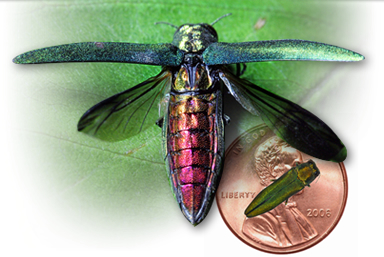 |
| Asian Longhorned Beetle- The threat in black and white TCIA Magazine 4-2012. | |
| Bad Bugs- Gypsy Moth, Asian Long horned Beetle, Hemlock Woolly Adelig 9-2009 | |
| Borers of Landscape Trees- 6-2009 | |
| Beetle Detectives: Beetle identification information | |
| 2nd Generation Bio Fuel Plants has new Risks - Plants may be invasive | |
| Feral Swine |
Wild Boars Invade The North Country- Wild pigs cause thousands in damage and are hard to catch. Ben Tabor (NYSDEC region 5) interviewed by news channel 5 (WPTZ).
|
Wily, Elusive Foragers Invade Upstate New York- New York Times article on feral swine 3-11-2012. |
North Country Public Radio- Feral hogs invade the Champlain Valley |
NYS Invasive Species- Webpage on feral swine and other invasives |
This section deals mainly those efforts that represent a concerted effort to deal with invasive's. If you are looking for more information on individual lakes efforts look at our Milfoil Project Page for Eagle Lakes efforts to date, or try our Aquatic Invaders section for information on other lakes efforts.
- Lake Management Plans (Eagle Lake) Page- a brief synopsis of the more viable milfoil control methodologies (including benthic barriers, herbicide, hand/mechanical harvesting, etc.) as outlined in the ENSR Supplemental Environmental Impact Statement for Eagle Lake.
- Lake Management Planning Guides Page- General guides to forming a lake management plan as well as management alternatives on other lakes.
- Washington State Department of Ecology Web site A great overview of aquatic herbicides for plant management including modes of uptake, herbicides available, advantages and disadvantages, basic cost comparisons, and links to environmental impact statements.
- Herbicide Information Page- general and specific information about two of the herbicides (Renovate and Sonar) that are NYS registered for the control of milfoil. MSDS, Product Labels, Environmental Impact Statements, FAQ's, etc.
- Pre and Post Treatment Plant Survey Page- a compilation of documents that have been found on the internet or provided by applicators or lake managers related to the application of the herbicide Renovate.
| Agency's with a Regulatory Interest | Lake Management Organizations | Commercial Lake Management Products | NYS Invasive Species Task Force (Governor Pataki's Initiative to Combat Invasive Species in New York State) |
| Adirondack Park Agency (APA) | Allied Biological- Home Page | Lake Bottom Blanket- A premade benthic barrier material, just add ballast |
Invasive Species Task Force Page- Detailed information about Eagle Lake's involvement with the Invasive Species Task Force. |
| NYS Department of Environmental Conservation (DEC) | Lycott Environmental- Home Page | NYS ISTF 2006 Final Report- Invasive Species recommendations for NYS 2006 (901 KB) | |
| NH Department of Environmental Services (Exotic Species Program) | Vermont Listing for Pond and Lake Managers |
Turbidity Curtains Page- Information related to materials, costs, deployments, and accessories that can be used for creating a lake within a lake.
|
Executive Summary- Final report summary |
| APA Rules (Adirondack Reporter) | Adirondack Ecologists- Home Page |
Curtain Containment Leakage Testing Page- Proposals and materials for determining water exchange rates in curtain contained areas.
|
Invasive Species Council Formation- Press release following the recommendations of the Invasive Species Task Force |
Adirondack Park |
Cedar Eden Environmental Llc. (Aquatic Plant Image Library) | Page 79- reference to Eagle Lake in ISTF | |
| New York Natural Heritage Program (for threatened/rare/ endangered plants) | Aquatic Control Technology (ACT)- Home Page | Page 114 - 117- reference to ELPOI member on ISTF | |
| FL-LOWPA (Finger Lakes- Lake Ontario Watershed Protection Aliiance) | Page 72- reference to Coalition of Lakes against Milfoil (COLAM) in ISTF |
|
|
|
This section is a limited collection of videos on invasive species. Most of the videos below focus on Eurasian Water milfoil and its' control.
| Eagle Lake Videos |
Wild Boars Invade The North Country- Wild pigs cause thousands in damage and are hard to catch. Ben Tabor (NYSDEC region 5) interviewed by news channel 5 (WPTZ).
|
Milfoil in Eagle Lake Video Page- 2006 video documenting an in the water view of the milfoil problem at select locations in Eagle Lake.
|
Hand Harvesting and Matting Video Page- 2008 video of mat placement and hand harvesting operations in Eagle Lake
|
Milfoil Patch Swim Around Video Page- 2008 video that is designed to be an educational tool to illustrate just how much of a problem the milfoil is in Eagle Lake, as well as to illustrate the dense mono cultures that exsist in the lake.
|
| Other Lake Videos |
Didymo Algae Video- progression of algae in a "fine tailwater trout fishery in MD and well worth the time to watch (~25 min)."
|
Why Aquatic Herbicides Affect Aquatic Plants and Not You!- Good descriptive video of aquatic plant types (monocot vs dicot) and herbicide action related to nuisance plant control.
|
| Skaneateles Lake Milfoil 1 (news report) |
| Skaneateles Lake Milfoil 2 (lake report) |
| Cazenovia Lake logic behind Renovate Use |
| MiddFoil- A Natural Method to Control Eurasian Water milfoil (use of weevils) |
| Operation Love the Lake (near shore mat placement) |
| Lake Bottom Blanket - Aquatic weed control benthic barrier |
| NYinvasives Channel on YouTube | |
This morning we are pleased to announce the NYinvasives Channel on YouTube where all past presentations from our NY Invasive Species Speaker Series are now available. Visit youtube.com/NYinvasives and become a subscriber. Subscribers will be alerted as new material is posted. The posted presentations only contain the featured presentation - the PRISM round-robin and Q&A will still be available via the recorded WebEx link for those who want to hear a call in its entirety. Please share the NYinvasives YouTube Channel link with your partners and invite them to learn more about the great work being done in New York to combat invasive species. |
|
This section focuses primarily on those species that while native to the Adirondack region, still have a negative environmental impact in large numbers, or that interfere with the maintenance and use of the Eagle Lake watershed.
| Nuisance Animals | ||
| Beavers | Canada Geese | Cormorants |
| Beaver Control Techniques NYS DEC Removal Guide | When Geese Become a Problem | Cormorants on Lake Champlain |
| ELPOI Beaver Removal Permit: 9/08 - 12/08 | Permit Requirements (DEC Q&A) | Cormorants on Lake Champlain U.S. Fish and Wildlife |
| Nuisance Canada Geese (DEC General Information | Cormorants U.S. Fish and Wildlife Service | |
| Canada Geese and Double-crested Cormorants- page 5 of the 2007 Lake George Newsletter | Cormorants Vermont Public Radio discussion | |
| Double-crested Cormorants and Canada Geese- page 5 of the 2007 Lake George Newsletter | ||
This section focuses on the issues that affect the quality of fishing in Eagle Lake. It also focuses any health risks that may be associated with eating fish caught in the Adirondacks in general. No specific restrictions currently apply to Eagle Lake.
- Boater Safety Information- This page includes publications about the "rules of the road" and polite use of recreational watercraft on Eagle Lake and other navigable inland waterways.
|
30" Brown Trout- Caught through the ice, winter of 2012.
Protecting Hamilton County from Spiny Water Flea-
8-10-2011 Adirondack Almanack article about the invasive, it's impact on fishing, and steps you can do to stop it's spread.
Invasive Species? It won't happen to me- Times of Ti Joe Hackett opinion for taking responsibility for cleaning ones own personal fishing gear (10-2010).
Sportsmans Connection write up and review of fishing in Eagle Lake (10-1-2010).
Where do Fish Really go in Winter? Observations from New York waters.
Diagnosis of Fish Diseases in the Upper Midwest Minnesota Sea Grant
May 7 2005 Marks Opening Day for Many Popular Game fish Species (What opens when, cautions for consumption, and prevention of invasive spread)
Chemicals in Sport fish and Game: 2007-2008 Health Advisories (New York State Department of Health (DOH) information about fishing and game harvest)
Adirondack Park Fish Advisory (New York State Department of Health (DOH) Adirondack Park specific information about fishing and game harvest)
NY Takes Emergency Action to Prevent the Spread of Fish Pathogen- Viral Hemorrhagic Septicemia: Fish Disease, no effect in humans
New York State Conservationist New York's battle to stop the spread of invasive species (fishing issues, and others)
Fish Stocking Information Page- Data related to fish stocking in Eagle Lake
|
Currently located at several locations in Lake George.








